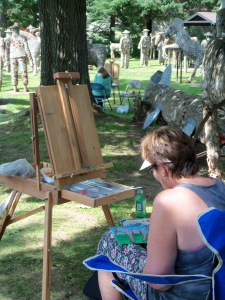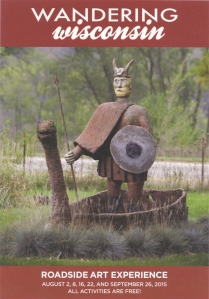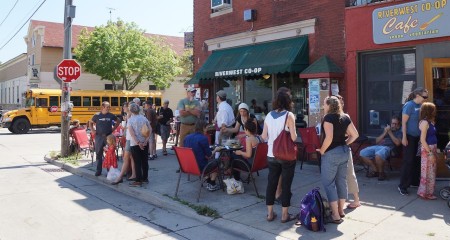
Noon gathering at Riverwest Co-op and Café. Photo © by Lee Matz.
With the assistance of wonderful weather, over 400 nurturing relatives and friends arriving during the course of the day, Milwaukee’s Jim Godsil celebrated his 70th birthday on August 22. Affirming his uniquely inclusive style, the festivities began with a relaxing bus tour and concluded with Godsil’s festive Southside Rainbow Street Party of “100 Names.”
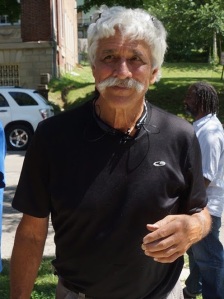
James Godsil at his 70th year birthday party. Photo © by Lee Matz.
The date chosen honors the following important organizations in Godsil’s life: the 40th year of Community Roofing and Restoration – the main event sponsor, the 10th anniversary of the Milwaukee Renaissance Wiki Magazine, the 5th anniversary of the Sweetwater Foundation and the one-year anniversary of Heart Haus, the tour’s final destination.
Intermingling from “hither and yonder,” guests appeared representing diverse family members, community advocates, gender diversities, artistic professions, religious persuasions, political interests, age and education ranges and class designations.
“All I wanted to do was expand the value of my 70th birthday to include jump-starting a rainbow artist and adventurer boundary-crossing drum-bus party experiment,” Godsil said. “I hoped to introduce European Americans to the wonderful neighborhoods, galleries and studios of African American artists on the North side and introduce African Americans to a south side European American neighborhood. I hoped to mix up all of God’s children with good food, good drink, good music and a street party celebration and it worked!”

Purple Cow Bus at Riverwest Coop. Photo © by Lee Matz.
Starting at noon, Godsil greeted his first round of bus riders as they gathered at Riverwest Coop and Café to board the 71-seat capacity Purple Cow Organics Bus donated for this event by Sandy Syburg. Traveling from all parts of the country, Godsil welcomed the attendance of his children Rachel, Megan, Joseph, and Bridie, as well as grandchildren Kate, Rebecca, Monilola, and Darragh, sons-in-law Jim Freeman and Ok Jeyifous, sisters JoAnn and Jean, and brother-in-law Joe Werth.
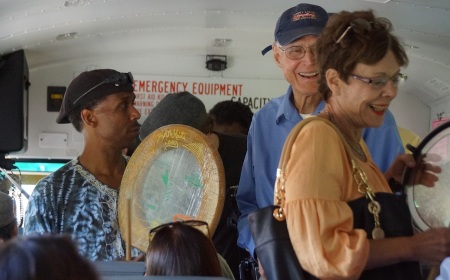
Tony Finlayson shared rhythms on the bus. Photo © by Lee Matz.
Bused to the Northside – Part 2
On the bus, Jahmés Tony Finlayson’s adept drumming established a comfortable ambiance. Marquette University’s Bob Pavlik, Riverwest backstreet Mayor Vince Bushnell and Seton Hall Law Professor Rachel Godsil joined 40 Riverwest activists.
The tour’s initial stop was Mother Clara Atwater’s and Toussaint Harris’ Gingerbread Land, which included several brightly colored houses and Atwater’s Love Tabernacle church. There another ten people boarded the bus..
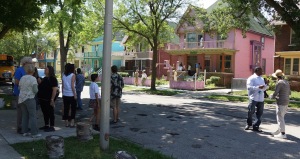
Gathering in Mother Clara’s Gingerbread Land. Photo © by Lee Matz.
The “rainbow” busload proceeded further into Milwaukee’s north side central city to explore additional treasures. The next stop was the Terry McCormick Contemporary Fine and Folk Art Gallery, located in Evelyn Patricia Terry’s two-story home.

Fondé Bridges passing out his Healthy Words sayings as the gallery visitors exit the bus. Photo © by Lee Matz.
Godsil said, “We feasted upon Fondé Bridges’ healing “Healthy Words” performance as Terry’s gallery greeter. The tour party went inside the gallery filled with room after room of beauty and listened to Evelyn’s great stories, which she continued after she boarded the bus to join the tour.”

Two young visitors to terry’s gallery. Photo © by Lee Matz.
Passing by Dep’s Hall of Fade and proceeding west to Lisbon Avenue, the bus unloaded its passengers to view Muneer Bahauddeen’s Ogbe Meji Studio exhibiting his finely crafted ceramic art. Some viewers momentarily slipped into the Amaranth Café across the street to buy a quick treat. Bahauddeen spoke outside to visitors about his vision to create an Amaranth Urban Sanctuary. Everyone participated in Finlayson’s Drum Bus Circle and sang Godsil’s birthday song before boarding the bus with new riders.
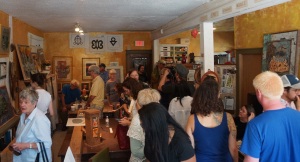
Muneer Bahauddeen’s captivating ceramic studio. Photo © by Lee Matz.
Bused to the Southside Finale – Part 3
Introducing Milwaukee’s Southside, the tour bus entered the site of the Old Main Soldiers Home Reef National Historic Landmark. Cleo Pruitt, who met us there, gave a moving tribute to forgotten soldiers of color as founder of the Rebirth of Freedom Project. She explained her vision of a future monument to them. Godsil observed, “The site astonished people with the terrible beauty of that sacred place.” Ms. Pruitt later joined the street party.
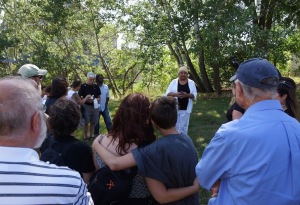
Cleo Pruitt explaining her Rebirth of Freedom Project. Photo © by Lee Matz.
As the finale, Ben Kohler’s Heart Haus team impressively hosted the Southside Rainbow Street Party of “100 Names.” “Foolosopher” Sky Schultz, in white cloth, silently greeted enlightened bus riders – arriving an hour late without complaints
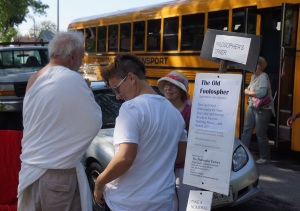
Foolosopher Sky Schultz welcomed the riders. Photo © by Lee Matz.

Poet Christina Zawadiwsky reads poetry. Photo © by Lee Matz.
Joining the party already in progress, the travelers settled in to participate in the merriment. They listened to award-winning Christina Zawadiwsky read poetry within the shadow of a specially constructed street stage. Howard Lewis, Holly Haebig, Dena Aronson and Jay Anderson provided music.
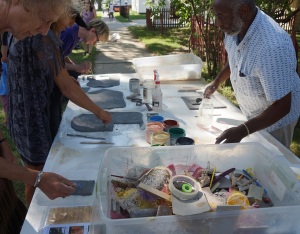
Muneer Bahauddeen on the right offering hands on art lessons. Photo © by Lee Matz .
Internationally collected artist, Della Wells and her great grandson, Momari Dejohnett, visited the designated inter-generational play area and Bahauddeen’s Peace Post Clay Table.
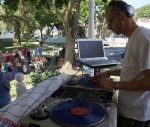
Tim Green record scratching. Photo © by Lee Matz.
Occupying a corner of the Heart Haus porch, Tim Green skillfully scratched records and played a range of music, welcoming revelers as they gathered “food and drink” from the house. Tables covered with Cheryl Sitzler’s African patterned tablecloths transformed the space.
Scrumptious rainbow entrees came from The Riverwest Coop Café, Juan’s Mom’s Tamale, Curt’s Chicken, Timbuktu and Martha’s Mighty Fine Foods. Janine Arseneau placed her six freshly baked fruit pies on a table in the street.
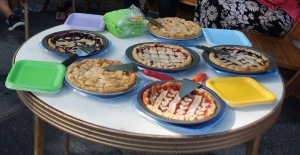
Janine Arseneau’s delicious fruit pies. Photo © by Lee Matz.
Brad Pruitt, an awarded documentary filmmaker, directed filming of this historical event.

Brad Pruitt speaking during bus tour. Photo © by Lee Matz.
Enjoying every moment, along with his guests, Godsil noted, “A European American retired doctor told me it was the most significant trip he had ever taken. An African American elder said it was a life-changing experience to see 20 and 30 African Americans celebrating with scores of European Americans in a south side residential neighborhood.”

Godsil’s Rainbow Street Party of “100 Names.” Photo © by Lee Matz.
Revelers delighted in the impact of Godsil’s mindfulness as a community and world force. Many openly expressed appreciation for Godsil’s refreshing wisdom, activism, buoyant nature, enthusiasm, supportive language and visionary joyfulness. He plans many more celebrations until his 100th birthday!
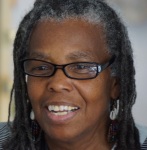
Evelyn Patricia Terry Photo © by Lee Matz.
Evelyn Patricia Terry wrote this blog. Jim Godsil’s interest in associating with creatives of like minds from many facets of the community particularly impressed her. Volunteer editors and proofreaders are welcome and needed as artists continue to strive to increase our state’s art profile. Reach her at the email address terryevelyn@hotmail.com with any corrections. Plus, because hacking into websites happened, Terry is reconstructing her website.
 Years ago, from the 1930s though the 1950s,, an immigrant Hollandale dairy farmer named Nick Engelbert created a fantasy land of statues in his yard and embellished his house with found objects stuck in concrete. Known as Grandview, the place still exists and is a sanctuary of sorts, open to the public free of charge. Today many call places like this art environments. You’re surrounded.
Years ago, from the 1930s though the 1950s,, an immigrant Hollandale dairy farmer named Nick Engelbert created a fantasy land of statues in his yard and embellished his house with found objects stuck in concrete. Known as Grandview, the place still exists and is a sanctuary of sorts, open to the public free of charge. Today many call places like this art environments. You’re surrounded.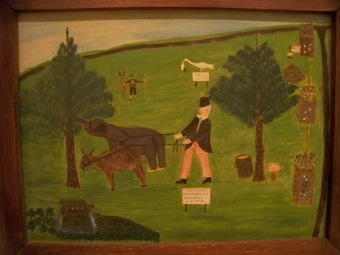



 Posted by rickyrolfsmeyer
Posted by rickyrolfsmeyer 

















